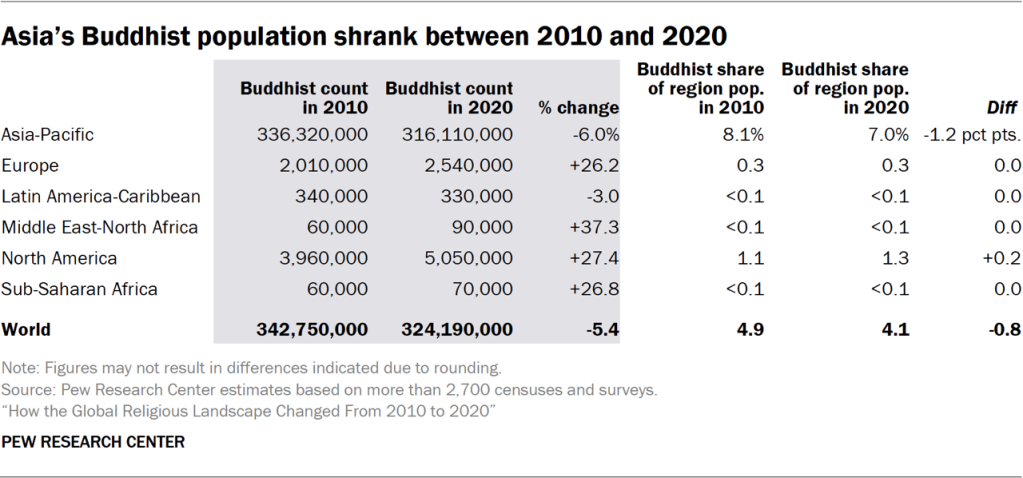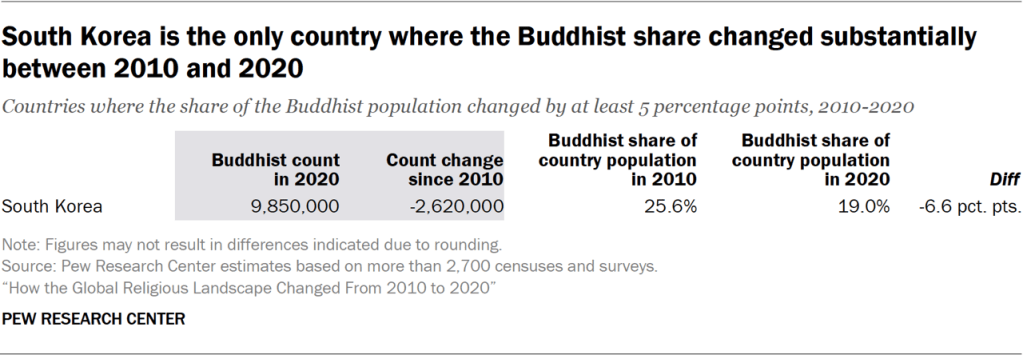Buddhists are the only group in this report whose number declined worldwide between 2010 and 2020. This was due both to religious disaffiliation among Buddhists in East Asia and to a relatively low birth rate among Buddhists, who tend to live in countries with older populations. Most of the world’s Buddhists (98%) reside in the Asia-Pacific region, the birthplace of Buddhism. Outside Asia, only North America and Europe have more than 1 million Buddhists each.
Global change
The number of Buddhists around the world declined 5%, from 343 million in 2010 to 324 million in 2020. No other major religious group shrank in absolute numbers during this period. The decrease in Buddhists was largely due to declines in East Asian countries, such as China (down 23 million) and Japan (down 7 million).
During this decade, the rest of the world’s population grew by 13%. As a result, Buddhists declined as a share of the world’s population, from just under 5% in 2010 to just over 4% in 2020.

Regional change
In two regions, there were fewer Buddhists in 2020 than in 2010. In the Asia-Pacific region, the number (or count) of Buddhists declined by 6% to 316 million. In Latin America and the Caribbean, it declined by 3% to 330,000.
Elsewhere, the Buddhist count increased between 2010 and 2020. In North America, it rose by 27% to 5.0 million. In Europe, the number of Buddhists grew by 26% to 2.5 million.

The small Buddhist populations in the Middle East-North Africa and sub-Saharan Africa regions also are estimated to have grown sharply while still numbering fewer than 100,000 in each region in 2020.
Although the Buddhist count changed in every region between 2010 and 2020, the share of the population that is Buddhist did not change much in most regions. In the Asia-Pacific region, the Buddhist share dropped by about 1 percentage point.
Regional distribution of Buddhists
Since 2010, the geographic distribution of the world’s Buddhists has changed little.

As of 2020, the Asia-Pacific region remains home to most of the world’s Buddhists (98%), and the rest continue to live mostly in North America (2%) and Europe (1%).24
However, there was a slight shift in the geographic concentration of Buddhists between 2010 and 2020. The percentage of the world’s Buddhists living in Asia declined slightly, while North America and Europe experienced small increases in their shares of the global Buddhist population.
Countries with the highest Buddhist counts
Thailand has the world’s largest number of Buddhists, with 68 million, making up 94% of the country’s population.

China has the second-largest number of Buddhists (53 million), although Buddhists account for just 4% of China’s overall population.
Buddhists form a majority in seven countries: Cambodia (97%); Thailand (94%); Myanmar, which is also called Burma (89%); Bhutan (75%), Sri Lanka (70%); Laos (64%); and Mongolia (51%).
The 10 countries with the largest numbers of Buddhists are home to 91% (or 296 million) of the global Buddhist population.
Among the 10 countries with the largest numbers of Buddhists, only four – Cambodia, Thailand, Myanmar and Sri Lanka – have Buddhist majorities. Elsewhere, Buddhists form minorities and sometimes comprise a tiny fraction of the overall population. For example, India’s Buddhists (approximately 10 million) make up less than 1% of the country’s population.
Where did the Buddhist share of the population change the most?
Between 2010 and 2020, the share of a country’s population identifying as Buddhist only changed substantially (by at least 5 percentage points) in South Korea.
In South Korea, the percentage of Buddhists dropped over the decade by about 7 points (0r 2.6 million people) to 19%. Many South Koreans who were raised Buddhist have left their childhood religion.

The number of Buddhists in China and Japan declined considerably, but their shares in these countries – which have relatively large overall populations – changed by less than 5 points.
Buddhists are losing adherents in these countries not only due to widespread disaffiliation – people leaving religion after having been raised Buddhist – but also because Buddhists in these places tend to be older than the general population and therefore closer to the end of their lives.




